Vertical heating radiators: types + advantages and disadvantages + brand overview
When planning a room heating system, you should pay attention to the vertical heating radiators, which are selected for any elegant interior. However, the effective design of the device is somewhat leveled at a considerable price, the specifics of connection and operation, which should be dealt with before buying. Do you agree?
We will talk about all types of vertical radiators on the market. In the article we proposed, varieties are described in detail, their design features and technical characteristics are given. To facilitate the solution of the buyer's problem, we have listed the leading manufacturers.
The content of the article:
Classification of heating radiators
Vertical radiators are classified by material of manufacture, external design and type of heat source. These devices have a height of 1-3 meters and are similar to their horizontal counterparts with the exception of some features.
According to the material of manufacture
Vertical heaters have fairly overall dimensions and weight, so manufacturers try not to increase the load on the walls due to sections made of cast iron.
In addition, the complexity of processing this metal does not allow to give it a decorative shape. These factors exclude cast iron from materials for making high batteries.

The main types of vertical radiators, depending on the material of manufacture, are:
- bimetallic;
- aluminum;
- steel.
Modern bimetal heating appliances The good thing is that their tubes and the system of internal channels are made of steel, and the heat-emitting fins are made of aluminum. This allows you to combine in one device the strength and wear resistance of one metal and the good heat-conducting properties of another.
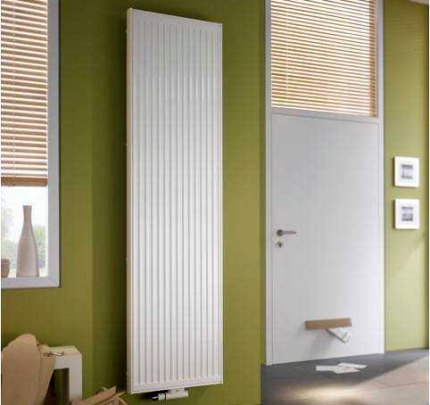
In addition, the ease of machining aluminum allows you to vary the appearance and shape of radiators over a wide range. This metal is well painted without losing its heat-conducting properties, which allows you to embed products from it into the interior, made in any palette.
The only drawback of bimetallic products is their increased cost. Steel heating sections are characterized by increased structural strength, but among all vertical radiators they have the worst heat dissipation.
Steel does not lend itself to precision machining, so the appearance steel alloy batteries often not distinguished by sophistication. In addition, steel structures are susceptible to corrosion, even if they are coated with a special coating.
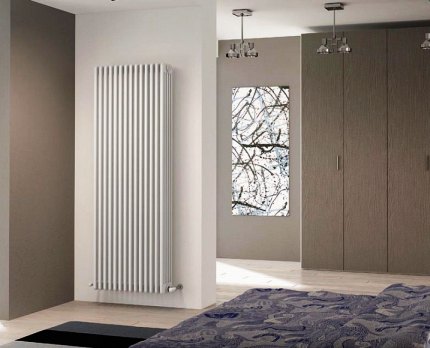
Steel sections are often made in panel design, which allows you to hide pipes and channels behind external metal plates. The advantage of such radiators is their price, which is lower than that of products from other materials.
Aluminum heating sections have the best thermal conductivity among other materials. They heat up quickly, but also do not hold heat for a long time. Aluminum is a plastic material, so the batteries from it are distinguished by the sophistication of design forms.
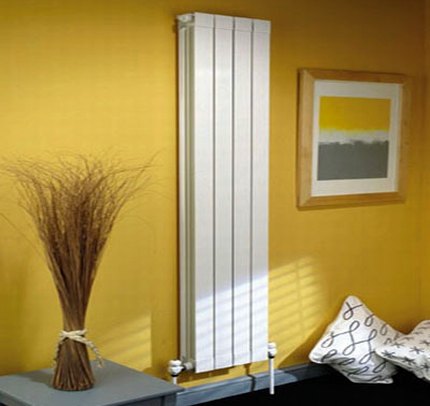
Due to the ease of manufacturing cost aluminum radiators lower than bimetallic, but their maximum working pressure is less. Weak strength does not allow the use of such radiators in multi-storey buildings and in central heating systems.
The material of the batteries is able to influence their choice only at high working pressure, so most often the products are bought based on their appearance and cost.
By external execution
The larger the area of the heat-reflecting surface of the heating metal elements, the higher their efficiency. Therefore, the shape of the battery design largely determines its energy performance.
All radiators in external design are divided into:
- sectional;
- tubular;
- panel.
Tubular vertical batteries consist of elongated pipe sections connected to the top and bottom by collectors. To give an elegant look, individual radiator elements are often bent. Such a device provides maximum heat transfer, but to preserve it, you must regularly wash the batteries from all sides.
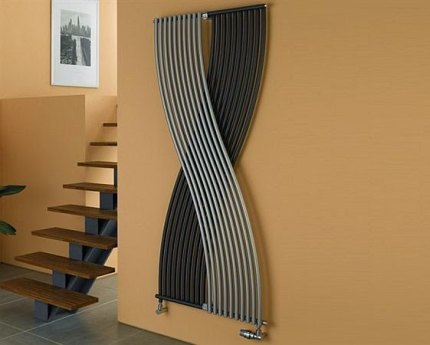
Such radiators are usually made of steel, and individual pipes are connected to the collector by a weld. Sectional batteries consist of several parts having a flat front surface.
They are characterized by the following features:
- they are predominantly bimetallic or aluminum, which compensates for the decrease in the working area when comparing their performance with tubular models;
- aesthetically fit into the interior;
- are more expensive than other types of batteries;
- give off heat mainly by convection;
- are collapsible, which allows you to dial an arbitrary number of sections in one battery.
Maintenance of sectional radiators is simple and does not require much time.
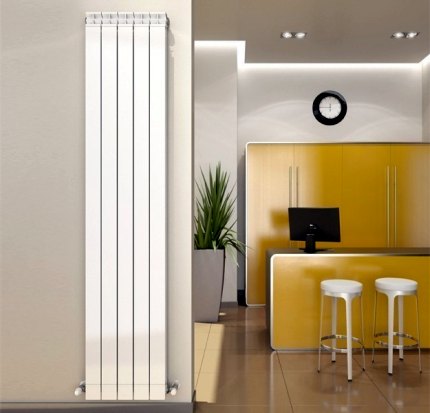
Panel batteries have a non-separable design, and their front panel is often represented by a single sheet of metal or glass. Particularly popular models with mirrored front surfaces, which are independent interior items. They expand the space of the room, adding light and internal heat to it.
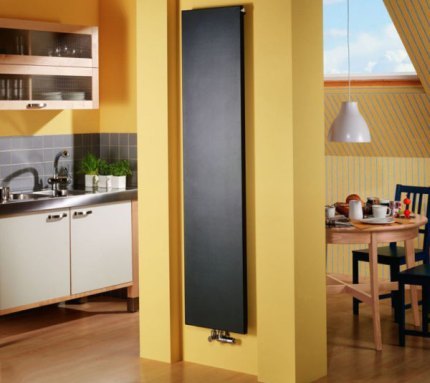
In the presence of an autonomous heating system, the energy efficiency of vertical radiators of various designs does not matter, because the heat generated by the boiler in any case will remain indoors.
By type of heat source
In most vertical heating appliances, water is used as a heat carrier, which is heated by a gas boiler. But there are batteries that use electric energy to heat. Their internal structure is similar to that in water batteries, only the role of the coolant is performed by a special oil.
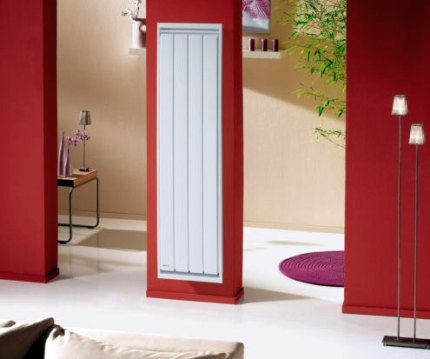
Using vertically oriented electric radiators economically costly, therefore they are used mainly for short-term auxiliary heating of premises.
Such equipment has built-in thermoregulation mechanisms, which allows it to be used only when the temperature drops below a set level.
Advantages and disadvantages of vertical radiators
Vertical radiators are an ambiguous version of the heating system. To install them, you need a free wall in the room and the ability to seamlessly bring pipes to the radiator with coolant.
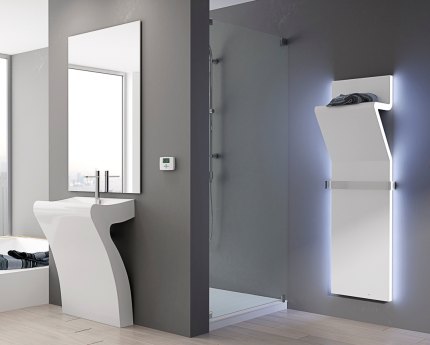
Despite this, vertical batteries continue to be in steady demand due to these advantages:
- High heat dissipation due to the large area of contact with air. This allows you to heat the coolant to a lower temperature and not overload gas boiler.
- Variety of shapes, sizes and colors, which allows you to choose a model of the required size for any interior.
- High heating speed premises due to contact with air throughout the height of the room. Particularly effective in this regard are aluminum devices.
- Easy installation due to the set of fasteners that comes with each battery.
- Space saving under the window where you can arrange a small pantry.
With the stained glass structure of the walls and the absence of a window sill, vertical wall-mounted batteries are ideal for a heating system.
Vertical radiators are also not without drawbacks, because of which they are not widely used.
The disadvantages of such batteries include the following:
- Uneven heating. Due to the vertical extension of the radiators, warm air rushes from them to the ceiling and accumulates there. As a result, the floor does not warm up well and remains cold.
- High price. The price of one simple vertical section 2 meters long is 60-150 dollars, and designer models are many times more expensive.
- The difficulty of stealth heating pipes. Ideally, the plastic wiring for vertical radiators should pass inside the walls behind the drywall, but this is quite difficult to implement.
- Heavy weight steel models, which does not allow the battery to be hung on drywall and thin interior partitions.
- The connection of vertical radiators is usually done according to the lower or seat scheme, which reduces heat transfer by 10-15% in comparison with diagonal or side mounting.
There are no fundamental structural differences between horizontal and vertical batteries.
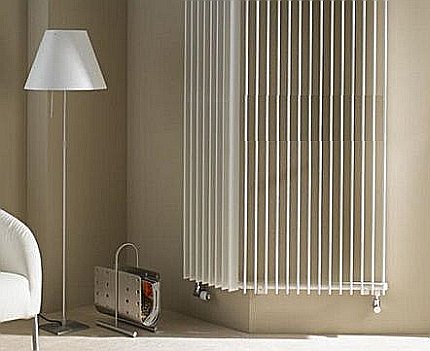
The latter simply have an elongated shape of intra-sectional channels. Therefore, when choosing radiators for heating system it is necessary to be guided mainly by the external beauty and ease of installation of equipment.
Vertical Radiators Manufacturers
Unfortunately, domestic companies do not produce radiators with a height of more than 90 cm. Most designer batteries are manufactured in European countries, where the population can afford to buy such expensive products in bulk.
The most famous manufacturers of vertical radiators are:
- Arbonia;
- Betatherm;
- Jaga;
- Caleido;
- Enix
- Korado;
- Fondital;
- Global
- E.S.A.
Swiss company Arbonia produces steel budget and exclusive radiators. The customer is offered tubular batteries up to 3 meters long, having up to 6 tubes in depth and up to 24 sections in width. Thus, the total number of channels can reach 144 pieces.
Hungarian manufacturer Betatherm produces designer tubular, panel and sectional batteries. Their front plate can be made of glass, metal or artificial stone with a printed pattern. The final cost of the product strongly depends on the embodiment.
Italian companies Caleido fondital and Global produce bimetallic and steel sectional and tubular radiators at affordable prices. All models have a rectangular shape without design frills.
Polish company Enix produces both simple and exclusive models of sectional and tubular radiators. The highlight of the batteries is the unusual shape of the ribs and their built-in backlight.
Belgian heating radiator concern Jaga focuses solely on exquisite batteries. Their cost is 5-10 times higher than the price of the equipment of competitors, but the appearance of the products is worth it.
Czech manufacturer Korado strive for minimalism and offers customers inexpensive panel and sectional radiators. You can choose from a range of 21 colors.
Many Turkish radiatorsE.S.A. ” are made with a mirror on the front panel and a coating with anti-corrosion properties. The batteries are manufactured using German equipment and have attractive prices.
Products of several dozens of other manufacturers of vertical radiators are presented in domestic stores, but their products are notable for their limited range or price, which does not correspond to the quality level.
An interesting novelty in the market of devices for heating systems are vacuum radiators. The specifics of their device and actions will be introduced by our recommended article.
Conclusions and useful video on the topic
You can evaluate the types of vertical radiators in a real situation and get acquainted with the process of their installation on the presented videos.
Video # 1.Overview of vertical models:
Video # 2. Installation Nuances:
Video # 3. What to consider when choosing:
Vertical heating radiators are incredibly attractive. To install these products for heating rooms, it is enough to find a place in the interior and funds to buy in your wallet.
And there is no doubt that after the installation of the equipment, the appearance of the heating batteries and their functionality will be appreciated by all the guests of the house or apartment.
Want to share your own experience in the selection and installation of vertically oriented heating appliances? Do you have useful information on the topic of the article? Please write comments in the block below, post photos, ask questions.

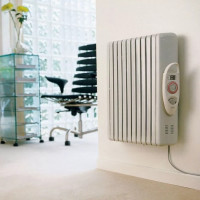 Electric heating radiators: the main types, advantages and disadvantages of batteries
Electric heating radiators: the main types, advantages and disadvantages of batteries 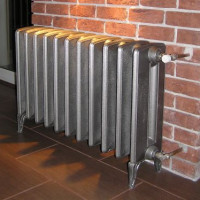 Cast-iron radiators: characteristics of batteries, their advantages and disadvantages
Cast-iron radiators: characteristics of batteries, their advantages and disadvantages 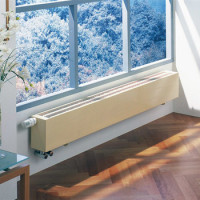 Water heating convectors: types, how to choose + an overview of popular models and brands
Water heating convectors: types, how to choose + an overview of popular models and brands  Steel heating radiators: varieties, characteristics and advantages of batteries
Steel heating radiators: varieties, characteristics and advantages of batteries 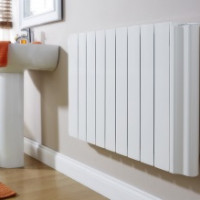 Vacuum heating radiators: overview of types, selection rules + installation technology
Vacuum heating radiators: overview of types, selection rules + installation technology 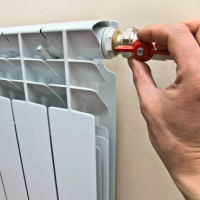 Aluminum heating radiators: overview of technical characteristics + installation principles
Aluminum heating radiators: overview of technical characteristics + installation principles  How much does it cost to connect gas to a private house: the price of organizing gas supply
How much does it cost to connect gas to a private house: the price of organizing gas supply  The best washing machines with dryer: model rating and customer tips
The best washing machines with dryer: model rating and customer tips  What is the color temperature of light and the nuances of choosing the temperature of the lamps to suit your needs
What is the color temperature of light and the nuances of choosing the temperature of the lamps to suit your needs  Replacement of a geyser in an apartment: replacement paperwork + basic norms and requirements
Replacement of a geyser in an apartment: replacement paperwork + basic norms and requirements
For the first time I learned about this type of radiator. Interested in. In my house in one room there is such a layout that you can’t put a regular radiator, but a vertical one would suit me. I think bimetal is quite suitable material. Not as good as cast iron, but quite reliable and durable. And certainly better than aluminum. It’s better to overpay for a good heating appliance, rather than chasing low cost.
Well, I don’t know, I wouldn’t definitely install a vertical heating radiator. It is made so that all the heat will go to the ceiling, and the floor will be cold. And this despite the fact that the radiators of this design are decently more expensive than the classic horizontal. In general, a purely situational thing may come in handy somewhere, but obviously you can’t warm a room completely with such a thing.